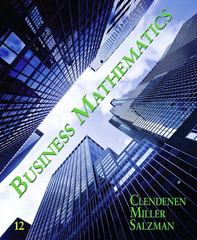Question
Maxine Peru, CEO or Peru Resources just received the engineering report. The report described a proposed new mine on the North Ridge of Mt. Zircon.
Maxine Peru, CEO or Peru Resources just received the engineering report. The report described a proposed new mine on the North Ridge of Mt. Zircon. A vein of transcendental zirconium ore had been discovered there on land owned by Ms. Peru's company. Test borings suggested a 90% probability that there exist sufficient reserves to produce 340 tons per year of transcendental zirconium over a 7 year period and a 10% probability that reserves would be too small to justify mining operations. There was also a 20% probability that the vein contained hydrated zircon gemstones. The quantity and quality of those zircons were hard to predict, since they tended to occur in "pockets". The new mine might come across one, two, or dozens of pockets. The mining engineer guessed that 150 pounds per year might be found. The current price for high-quality hydrated zircon gemstones was a$3,300 per pound. Peru Resources was a family owned business with total assets of $45 million, including cash reserves of $4 million. The new mine would require a major financial commitment. Fortunately, the company was conservatively financed and Ms. Peru believed that it could borrow up to $9 million at an interest rate of about 8%. The mine's operating costs were projected at $900,000 per year including $400,000 of fixed costs and $500,000 of variable costs. Ms. Peru thought these forecasts accurate. The big question marks seemed to be the initial cost of the mine and the selling price of transcendental zirconium. Opening the mine and providing the necessary machinery and ore-crunching facilities would take one year and was expected to cost $10 million. However, costs of overruns of 10% or 15% were common in mining. In addition, new environmental regulations if enacted in this legislative session could increase the cost by 1.5 million. There was a cheaper design for the mine that would reduce its cost by $1.7 million and eliminate much of the uncertainty about cost overruns. Unfortunately, this design would require much higher fixed operating costs. Fixed costs would increase to $850,000 per year at planned production levels. The current price of transcendental zirconium was $10,000 per ton but there was no consensus about future prices as an organized futures market did not exist. Some experts were projecting rapid price increases to as much as $14,000 per ton. On the other hand, there were pessimists saying that prices could be as low as $7,500 per ton. Ms. Peru did not have strong views either way. Her best guess was that price would just increase with inflation at about 3.5% per year but there was a 20% probability that the pessimists were correct and a 20% probability that the optimists were correct. Mine operating costs would also increase at the same inflation rate. Ms. Peru had wide experience in the mining business and she knew that investors in similar projects usually wanted a forecasted nominal rate of return of at least %14. Assume that Peru Resources pays tax at a 35% rate. For simplicity, assume that the investment in the mind could be fully depreciated for tax purposes straight line over 7 years (assume one year development and the half year depreciation convention apply) You have been asked to help Ms. Peru in evaluating this project: C: Draw a decision tree D: (Using excel) determine the NPV only for best and worst case scenarios: What is the appropriate cost of capital? What scenarios should worry Ms. Peru the most? Is there a case for delaying the construction of the new mine?\
Step by Step Solution
There are 3 Steps involved in it
Step: 1

Get Instant Access to Expert-Tailored Solutions
See step-by-step solutions with expert insights and AI powered tools for academic success
Step: 2

Step: 3

Ace Your Homework with AI
Get the answers you need in no time with our AI-driven, step-by-step assistance
Get Started


